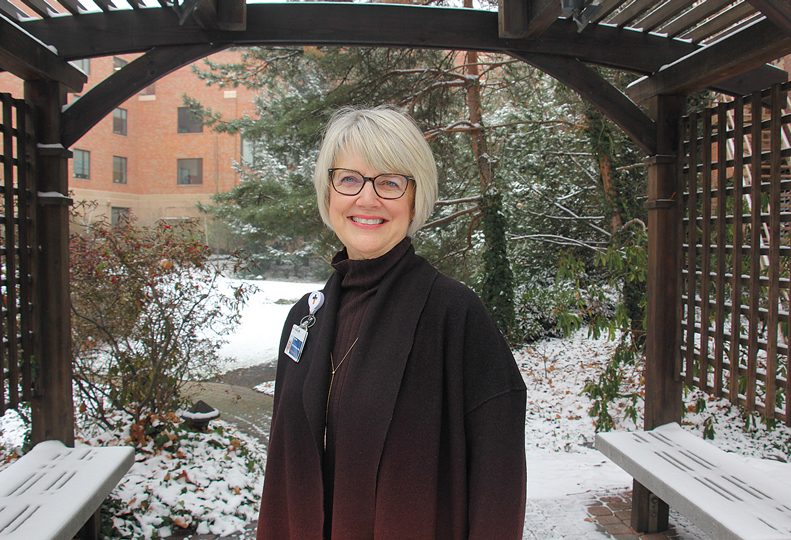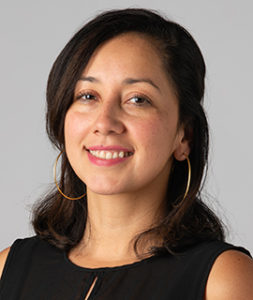
Home » Parting Thoughts with Providence's Peg Currie
Parting Thoughts with Providence's Peg Currie
Chief executive, Providence Sacred Heart

December 16, 2021
Peg Currie, chief executive of Providence Sacred Heart Medical Center & Children’s Hospital and chief operating officer of Providence Inland Northwest Washington, is retiring at the end of next month.
Currie is capping a 40-year health care career. A Montana native, she received her nursing degree from Montana State University and her master’s degree in organizational planning from Gonzaga University. In her chief operating officer role, she oversees Providence’s Inland Northwest service area, including Sacred Heart, Holy Family Hospital, and St. Luke’s Rehabilitation Medical Center, in Spokane; Mount Carmel Hospital, in Colville; and St. Joseph’s Hospital, in Chewelah.
Currie is part of the senior leadership team that works hand in hand with Shelby Stokoe, Providence Inland Northwest Washington chief financial officer, to contribute financial decisions impacting the Inland service area.
The Journal recently sat down with Currie to discuss her career in health care, what drew her to a leadership role, and her experience in handling the COVID-19 pandemic.
You began your career as a nurse at Providence. What drew you to pursue a role in leadership?
I would have to go back further in terms of how a person is shaped to want to go in that direction.
I was a product of the World War II generation. My dad did 25 missions over Germany. He grew up with hardship, but he learned to be resilient and to roll with it over the course of his life, which is something that I learned from him early on. My mom was a product of the Pentagon during World War II. She grew up in North Dakota and moved to D.C., unmarried in the 1940s and was the assistant to a secretary general in the military, which is remarkable.
Both my parents shaped me for leadership, because you have to be resilient for leadership, and you have to be courageous and bold. Not everybody is going to like what you do; the buck stops with you. It’s not a job; it’s a lifestyle. This is something you have to be accountable for 24/7, especially in the last couple of years, these could not be more challenging. So much is at stake, so much death, so much divisiveness. You have to be tough.
You’re speaking specifically about COVID in the past two years?
Yes, right.
What was your initial reaction when all this happened?
One of the accomplishments I’m most proud of is I got a grant from the federal government with the support from the (Washington state) Department of Health to develop a four-state regional special pathogen center in 2014. That’s when there was an Ebola scare in Texas. They received the first case in the U.S., and everybody got really worried.
So we went through an assessment, and it was found out that out of the four-state region that we represent we were the most prepared. Now, that is good, but on the other hand, I thought, ‘oh my god, if we’re the most prepared, this country is in trouble.’
So we applied for the grant, and we got it. All the special training you see with the attention to detail and isolation techniques and the personal protective equipment, we learned in 2015, well ahead of what happened in COVID. I think that training made it easier.
Probably the most challenging part of the pandemic is that we didn’t know all the answers right away, just like we don’t have all the answers on the omicron variant right now. And, of course, in the beginning there was a short supply of personal protective equipment to keep people safe.
I read that you do a lot of workplace violence leadership, and it struck me as interesting for a hospital setting. Can you speak more about it?
That is a big initiative of mine. I’m so glad you brought it up. It’s been a huge frustration not only of mine, but of people who work at the bedside.
When people go through drug withdrawal, alcohol withdrawal, they can be very violent. As the epidemic of other substances has grown, so has the physical and verbal abuse toward health care providers in hospitals and clinics. We knew we needed to do more, and we also knew we didn’t want to have guns inside the walls of the hospital.
At a conference at Indiana University Trauma Center, someone described how the only thing that they tried that seemed to work when people get agitated and out of control is the presence of a trained canine to calm the situation.
One of my favorite moments is the hiring of (K-9 supervisor) Pat McKenna and his acquisition of our first canine, Sarge. Sarge is big and threating-looking on command, but he is wonderful and loves me. Pat and Sarge were the first K-9 unit at a Washington state hospital.
Then we have Dex, a drug-sniffing dog with his handler Cory, and we just got a third dog named Rocco, after St. Rocco, who holds special meaning and a sign of the times. St. Rocco is venerated as the protector against the plague and all contagious diseases.
All through my career there has been fantastic moments like that. There have also been really hard moments too. Life and death are not an easy thing for people to cope with, or for health care workers.
Can you speak more about that? What has been the most difficult part of your career?
Earlier in my career, the thought was being there for someone’s first and last breaths. And those are really sacred moments. You do your best to bridge that with people and help them feel the spiritual connection with both processes. Some deaths are very tragic, especially when it’s someone young.
In leadership, it is different. We are a mirror of society with the patients we have inside the walls of the hospital. There is a lot of denial or disagreement about treatment, whether its COVID or cancer or something else. That is something really hard for our doctors and nurses to cope with, particularly if someone is going to die and their family member wants something that’s inappropriate given to them, and they get angry. That’s what’s hard on them now.
In this role, my responsibility is to show gratitude. To inspire. To give recognition and thanks, of course. To listen, to understand and be available. The distress in the community is also the distress inside the walls of the hospital or clinic. I’ve never seen anything (before) that has divided what health care wants to do, which is take care of someone, countered with uneducated or misleading information that gives people the idea that we are not doing what we are supposed to be doing to take care of their loved one. That’s the hardest part right now.
How do you feel about retiring at such a critical stage?
I thought about it long and hard. My husband and I planned about when I would retire, and we decided to stick to the plan. It’s not like I do this job by myself. I have a great team. Not just locally, but regionally. We’re part of a big system now that really extends our ability to deal with something this amazingly crazy probably better than those that don’t have those resources.
With my nursing background, I will continue to support what’s going on with the pandemic and the community. I gave shots and boosters. I’m almost at the 800 mark. I know I’ll still be involved in some way.
I’ll also be a grandmother for the first time in April.
Looking back, nursing was the right career choice for me. It just gave me so many options. I’ve made a difference in a lot of people’s lives, and I feel really satisfied and happy. But I’m also ready to play a little now.
This interview has been edited for length and clarity.
Latest News Health Care
Related Articles




![Brad head shot[1] web](https://www.spokanejournal.com/ext/resources/2025/03/10/thumb/Brad-Head-Shot[1]_web.jpg?1741642753)
